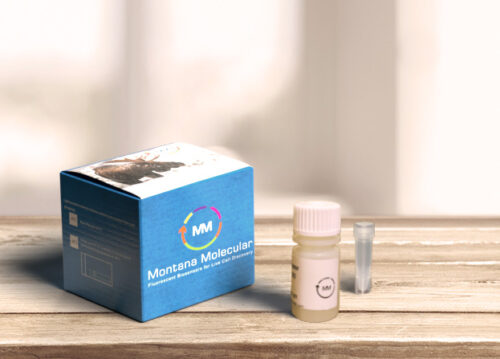Targeting Viral Entry
SARS CoV-2 entry into the human host cell is mediated by the Spike protein that decorates the surface of the virus and interacts tightly with Angiotensin Converting Enzyme 2 (ACE2) on the host cell. Tai et.al. recently showed that heterologous expression of ACE2 protein in HEK 293 cells is sufficient for pseudovirus entry when the pseudovirus expresses the SARS-CoV-2 Spike protein1. Using the brightest fluorescent proteins available and efficient BacMam delivery vectors, Montana Molecular is building a series of genetically-encoded biosensor assays that can be detected using automated fluorescence plate readers and imaging systems. BacMam is an enveloped virus that is non pathogenic to humans so initial screening can be done in BSL-2 facilities. BacMam produces consistent, controllable expression to enable assay optimization and reproducibility in living cells.
Pseudo host
Our pseudo host BacMam delivers ACE2 tagged with either a red or green fluorescent protein to any mammalian pseudo host cell. This assay can be used to visualize SARS CoV-2 entry into the cell or screen for drugs that block viral entry mediated by Spike protein.
SARS-CoV-2 Pseudo virus
Our pseudo virus is a BacMam vector, pseudo typed with the SARS-CoV-2 Spike protein. Spike protein will enable BacMam to enter the pseudo host through interaction with the ACE2 protein.
Read more about Montana Molecular’s platform for COVID19 drug development in this article from the Society for Laboratory Automation and Screening about SLAS community engagement in the fight against SARS CoV-2.
Three unique live cell assays signal viral entry into the pseudo host through changes in fluorescence and will also indicate when viral entry is blocked by a drug.
1) Red/Green Ratiometric Assay: The pseudo host will deliver both ACE2 protein and a red fluorescent protein to HEK 293 cells. The pseudo virus expressing mNeonGreen fluorescent protein will be introduced to the pseudo host. Successful entry over the next 24 hours will result in high green to red ratios, and successful blockade of entry will produce low green to red ratios. Assay can be detected on automated fluorescence plate readers to screen compounds or proteins that block viral entry.
2) Green Fluorescent Assay: The ratiometric assay described above, takes two days and involves two different fluorescent proteins. To create a faster signal of viral entry, that can be detected in a single channel, a pseudo host that expresses both the ACE2 protein and part of the mNeonGreen fluorescent protein that forms a nascent fluorophore. A pseudo virus BacMam vector that expresses the second part of mNeonGreen will produce a fully functional fluorescent protein when the pseudo host interacts with the pseudo virus.
3) SARS-CoV-2 protease biosensor: The advantage of the pseudo virus approach detailed above is that the reagents are BSL1 and compatible with automated drug discovery. Ultimately, agents that block viral entry must be tested on the SARS-CoV-2 virus under BSL-3 conditions. A BacMam vector delivered to a pseudo host will be engineered to express a fluorescent biosensor and cleavage sites for the SARS-CoV-2 Mpro protease. Within minutes of pseudo host exposure to SARS-CoV-2, the pseudo host produces bright green fluorescence.
- Tai, W. et al. Cell. Mol. Immunol. (2020) doi:10.1038/s41423-020-0400-4.





